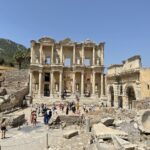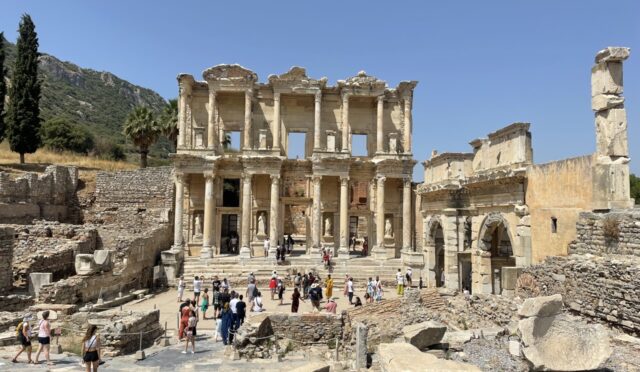The Celsus Library is one of the most iconic and well-preserved structures in Ephesus Ancient City, located in modern-day Turkey. Built in the 2nd century AD, this magnificent library was not only a center of knowledge and learning but also a grand monumental tomb dedicated to the Roman senator Tiberius Julius Celsus Polemaeanus.
Today, the Celsus Library stands as a symbol of the intellectual and architectural brilliance of the ancient world. With its stunning facade, impressive columns, and historical significance, it remains one of the most visited and photographed landmarks in Turkey.
In this article, we will explore the history, architecture, cultural importance, and present-day remains of the Celsus Library, while also providing useful travel tips for those planning to visit this remarkable site.

The History of the Celsus Library
The Celsus Library was built between 110 and 135 AD by Tiberius Julius Aquila, the son of Tiberius Julius Celsus Polemaeanus, who was a Roman governor of the Province of Asia. The library was constructed in honor of Celsus, who was a highly respected official and one of the most influential figures of his time.
Unlike other libraries in the Roman Empire, which were usually built by emperors or state officials, the Celsus Librarywas funded by private wealth, making it a unique example of personal patronage in the ancient world.
Why Was the Library Built?
The Celsus Library served two important purposes:
📚 A Center for Knowledge: It functioned as a public library, housing thousands of scrolls and manuscripts, making it one of the largest libraries in the ancient world after the Library of Alexandria and the Library of Pergamon.
⚰️ A Mausoleum: It also served as a tomb for Celsus, whose sarcophagus was placed in a crypt beneath the library. This was a rare practice, as Roman laws usually forbade burials within city centers.
The library became a symbol of wisdom, education, and Roman generosity, attracting scholars, philosophers, and visitors from across the empire.
Architectural Brilliance: Design and Structure
The Celsus Library is a masterpiece of Roman architecture, combining Greek and Roman influences in its design.
Key Architectural Features:
✅ Magnificent Facade: The library’s two-story facade is one of the most recognizable images of Ephesus. It is decorated with Corinthian columns, ornate carvings, and statues, creating an illusion of grandeur and depth.
✅ Statues of Wisdom: At the entrance, there are four statues representing Wisdom (Sophia), Knowledge (Episteme), Intelligence (Ennoia), and Valor (Arete). These qualities were highly valued in Greek and Roman culture.
✅ Interior Structure: The library’s reading rooms were located behind the facade, while the scrolls and books were stored in niches along the walls.
✅ Ventilation System: To protect the fragile papyrus scrolls, the architects designed a double-wall system, creating air pockets to regulate temperature and humidity, preventing damage from moisture.
✅ Grand Entrance: The library was accessed by a wide staircase, emphasizing its status as an important intellectual and cultural center.
With an estimated capacity of 12,000 to 15,000 scrolls, the Celsus Library was among the most important libraries in the Roman world.

The Destruction and Rediscovery of the Celsus Library
Despite its grandeur, the Celsus Library faced multiple destructive events over the centuries.
Major Events in the Library’s History:
📌 3rd Century AD – The Gothic Invasion: In 262 AD, the library was severely damaged by a fire during an invasion by the Goths, a Germanic tribe. The fire destroyed most of the interior, including the scrolls and wooden structures.
📌 Byzantine and Ottoman Periods: Over the centuries, the ruins of the library were further damaged due to earthquakes and neglect. By the Middle Ages, much of the structure was buried under debris.
📌 20th Century – Restoration Efforts: In the 1970s, archaeologists and historians undertook a major restoration project to reconstruct the library’s facade, using both original and new materials. Today, visitors can admire the majestic entrance, which has been carefully restored to reflect its original glory.
Cultural and Historical Importance
The Celsus Library was not only a center of learning but also a symbol of Roman influence in Asia Minor.
🎓 A Hub for Scholars: The library attracted philosophers, writers, and scholars from all over the empire. It played a crucial role in the intellectual life of Ephesus.
🏛 A Monument of Power: Its grandeur showcased the wealth and influence of the Roman elite in Ephesus, reinforcing Roman authority over the region.
🗺 A Tourist Attraction: Today, the Celsus Library is one of the top tourist attractions in Turkey, drawing millions of visitors each year.

Visiting the Celsus Library Today
The Celsus Library is located in Ephesus Ancient City, near Selçuk, İzmir Province, Turkey.
How to Visit the Celsus Library:
📍 Location: Ephesus Ancient City, Selçuk, İzmir, Turkey
🚆 How to Get There:
- From İzmir, take a train, bus, or car to Selçuk, which is about 1 hour away.
- The library is located within the Ephesus archaeological site, making it a must-see during your visit.
💲 Entrance Fee: Included in the Ephesus Ancient City ticket
🕰 Best Time to Visit: Spring and autumn offer the best weather conditions for exploring the site.
Visitors can also explore other nearby landmarks, such as the Temple of Artemis, the Great Theatre, and the Terrace Houses, for a complete experience of Ephesus’ rich history.
Conclusion
The Celsus Library is one of the greatest architectural and intellectual achievements of the ancient world. Though it suffered destruction over time, its restored facade continues to inspire visitors from around the globe.
A trip to Ephesus is incomplete without witnessing the majestic remains of the Celsus Library, a true testament to the cultural and scholarly heritage of the Roman Empire.
For a deeper dive into the wonders of the Ancient City of Ephesus, don’t miss our other article!













Comments (1)